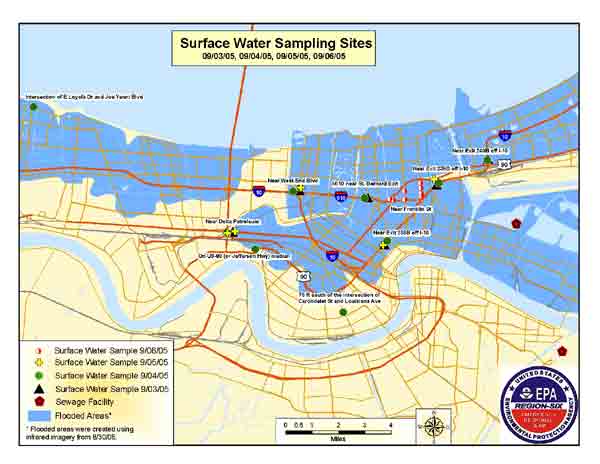Note: EPA no longer updates this information, but it may be useful as a reference or resource.
Water issues: Preliminary test results advisory
AUDIO TRANSCRIPT
Joint news conference
EPA Administrator Stephen L. Johnson
and CDC Director Dr. Julie Gerberding.
listen or download now
(MP3 21:22mins, 20 MB)
Mediaplayer ![]()
Flood water precautions
The U.S. Environmental Protection Agency and the U.S. Department of Health and Human Services are cautioning the public and all responders about the potential hazards associated with flood waters.
Every effort should be made to limit contact with flood water due to potentially elevated levels of contamination associated with raw sewage and other hazardous substances.
EPA and CDC Report High Levels of Bacterial Contamination in Preliminary
Floodwater Samples from New Orleans
September 8, 2005
Floodwaters from six locations across the New Orleans area were sampled by EPA and analyzed for chemicals and bacteria. These initial results represent the beginning of extensive sampling efforts and do not represent the condition of all flood waters throughout the area. Preliminary information indicates that bacteria counts for E. coli in sampled areas greatly exceed EPA’s recommended levels for contact. At these levels, human contact with water should be avoided as much as possible. Map of sampled areas.
Chemical sampling was performed for over one hundred priority pollutants
such as volatile organic compounds (VOCs), semivolatile organic compounds
(SVOCs), total metals, pesticides, herbicides, and polychlorinated biphenyls
(PCBs). Results from these analyses were compared to various Agency for
Toxic Substances and Disease Registry (ATSDR) and EPA health levels. Lead
concentrations in flood water exceeded drinking water action levels. These
measured levels are a concern if flood water were to be a child’s
source of drinking water. For the other chemicals tested, we have yet to
detect contaminant levels that would exceed the EPA and ATSDR health levels.
Due to the priority of the search and rescue mission, EPA testing has occurred
in several highly populated residential neighborhoods and not yet in heavily
industrialized areas.
Given these preliminary results, emergency response personnel and
the public should avoid direct contact with standing water when
possible. In the event contact occurs, EPA and CDC strongly advise
the use of soap and water to clean exposed areas if available.
Flood water should not be swallowed and all mouth contact should
be minimized and avoided where possible. People should immediately
report any symptoms to health professionals. The most likely symptoms
of ingestion of flood water contaminated with bacteria are stomach-ache,
fever, vomiting and diarrhea. Also, people can become ill if they
have an open cut, wound, or abrasion that comes into contact with
water contaminated with certain organisms. One may experience fever,
redness, and swelling at the site of the infection and should see
a doctor right away if possible.
Additional information regarding health and safety issues for both the public and emergency responders can be found on the Center for Disease Control (CDC) website (http://www.bt.cdc.gov/disasters/hurricanes/index.asp) and the Occupational Safety and Health Administration's (OSHA) website (http://www.osha.gov/OshDoc/hurricaneRecovery.html).
Preliminary flood water testing data will be confirmed through additional EPA testing and data analyses to ensure high quality. EPA is implementing a scientific process to ensure that the flood waters of New Orleans are thoroughly sampled for multiple types of key contaminants as appropriate. EPA is actively coordinating all sampling activities and data analyses with federal, state, and local agencies.
Flood water sampling map
View a high-resolution of this map (JPG 152K) (click "back" on your browser to return here)
More information about flood water.
![[logo] US EPA](../gif/logo_epaseal.gif)
